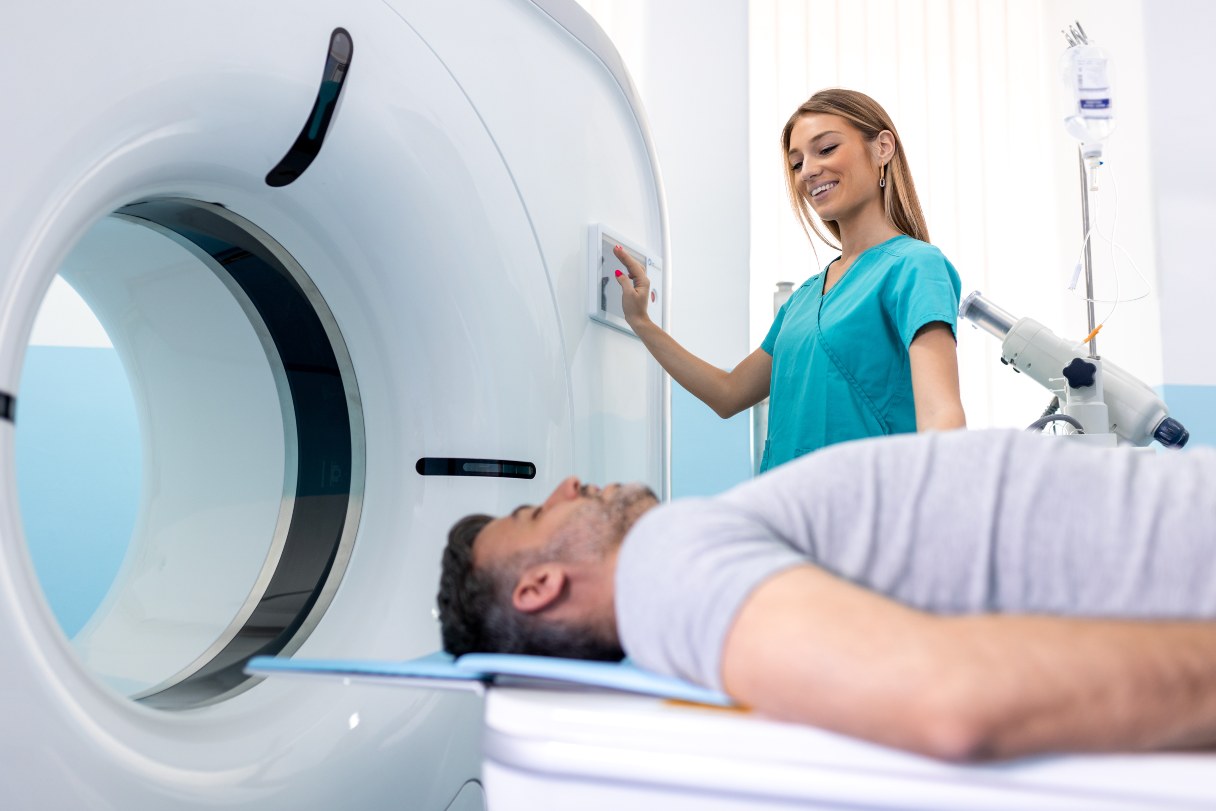If your doctor recommends you get an MRI, you may wonder what that is and how much it costs. MRI, which stands for magnetic resonance imaging, is a popular medical procedure for diagnosing abnormalities and monitoring treatment.1 The cost of an MRI varies based on the body part scanned, your location and other factors.2
Keep reading to learn more about what to expect during an MRI, how it works, how much it costs and more.
What Is an MRI?
An MRI is a noninvasive scan that can produce detailed images of nearly every structure inside the body, including organs, bones, muscles and blood vessels.3 Your doctor may order an MRI to detect a disease, diagnose a medical condition or monitor your current treatment.4
While an MRI is not used to diagnose broken bones, it can help detect many other conditions throughout the body.5 These conditions may include:6
- Abdominal or digestive tract problems
- Bone diseases and conditions
- Brain abnormalities and dementia
- Heart damage
- Lung damage
- Pelvic problems
- Problems with the eyes or ears
- Problems with the veins or arteries
- Prostate problems
- Spinal problems
- Sports injuries
- Tumors
How Much Does an MRI Cost?
In the United States, the average cost of an MRI is $1,325.7 However, an MRI can cost anywhere from $400 to $12,000, depending on various factors.2
MRI costs by body part
The cost of an MRI may vary according to which body part is being scanned.2 For example, MRI costs may be higher for an area like the brain, which requires more detailed analysis from a specialist.2
Check out this chart to compare the average cost of an MRI by body part:7
| MRI procedure | Average cost |
|---|---|
|
General |
$400 to $5,700 |
|
Lower extremity (foot, ankle, leg, hip) |
$975 to $6,300 |
|
Upper extremity (shoulder, arm, wrist, hand) |
$1,050 to $7,000 |
|
Abdominal |
$1,600 to $7,600 |
|
Bone |
$410 to $2,100 |
|
Brain |
$1,600 to $8,400 |
|
Breast |
$500 to $10,300 |
|
Cardiac |
$430 to $6,500 |
|
Cervical spine |
$1,400 to $7,600 |
|
Chest |
$500 to $7,900 |
|
Head |
$410 to $6,100 |
|
Neck |
$500 to $11,800 |
|
Pelvic |
$500 to $7,900 |
MRI costs by location7
The cost of an MRI can also vary by location. A rural location may have fewer MRI facilities to choose from, which can increase your costs. Conversely, a city with many MRI facilities may offer some lower-cost options.
This chart below compares the average cost of an MRI by city.
| MRI location | Average cost |
|---|---|
|
Atlanta, GA |
$550 to $1,400 |
|
Chicago, IL |
$575 to $1,500 |
|
Dallas, TX |
$500 to $1,300 |
|
Houston, TX |
$525 to $1,400 |
|
Los Angeles, CA |
$460 to $1,200 |
|
Miami, FL |
$550 to $1,450 |
|
New York, NY |
$625 to $1,600 |
|
Philadelphia, PA |
$575 to $1,500 |
|
Phoenix, AZ |
$525 to $1,350 |
|
Washington, DC |
$550 to $1,400 |
Additional MRI cost factors2
There are a few more factors that can impact the cost of an MRI, including:
- Facility. An MRI is typically less expensive at an outpatient facility (like a freestanding MRI center) than an inpatient facility (like a hospital).
- MRI with contrast. If your doctor orders an MRI with contrast, that can increase the total cost by about $110 to $310.
- Medication. If you need to be sedated (i.e., oral sedation, IV conscious sedation or general anesthesia), that can increase the cost of your MRI.
Cost-saving options for an MRI
If you're looking for the least expensive place to get an MRI, freestanding imaging centers, walk-in clinics and urgent care facilities tend to be the most affordable options.2
You can also connect with MDsave, a marketplace that partners with providers to offer affordable rates on medical procedures for patients to purchase directly online.8 Through MDsave, the national average cost of an MRI with and without contrast is $819.8
Is an MRI Covered by Insurance?2
MRIs are typically covered by insurance, but it's important to check your health plan to see if you need pre-authorization from your insurer. Look for an in-network MRI facility, which will typically charge a much lower rate than an out-of-network provider.
While some health plans will cover 100% of your MRI costs, others require you to pay a deductible, copay or coinsurance. You may be able to use your health savings account or flexible spending account to reduce these out-of-pocket expenses. You can also ask your healthcare provider about discounts, assistance programs or medical payment plans to reduce the up-front cost of your MRI.
How Does an MRI Work?
An MRI uses powerful magnets and radio waves — not radiation — to produce images on a computer.3 Here's how it works:3
- First, the MRI machine creates a strong magnetic field that causes the atoms in your body to align with that field.
- Then, the MRI machine transmits radio waves that move your atoms out of their original position.
- Once the radio waves are turned off, your atoms realign with the magnetic field and send back radio signals.
- A computer receives these signals and converts them into images.
These internal images can help your doctor learn more about your condition and make a more precise diagnosis.1
MRI with contrast6
Your doctor may order an MRI with contrast, which may provide more detail and improve the quality of the images produced. If your doctor orders an MRI with contrast, a dye will be injected into your body right before the scan. The injection is typically given through an IV in the back of your hand or the inside of your elbow.
Types of MRI Machines: Open MRI vs. Closed MRI
There are two main types of MRI machines: open and closed.9 Here are the key differences between the two:
Closed MRI5
- Has a tube-like tunnel that's open on one end only
- Has a ring of magnets that encircle the entire body
- Typically produces clearer images
Open MRI5
- Has open sides
- Has two magnets: one above the body and one below
- Can more easily accommodate people who are tall, heavy or broad-shouldered
- Can help prevent feelings of claustrophobia
- May be less noisy
If you're sensitive to sound or concerned about tight spaces, ask your doctor if an open MRI is a good option for you.5
MRI vs. CT Scan
An MRI and a computed tomography (CT) scan both produce images of the bones, organs and other internal tissues.6 Here's a quick look at how the two scans differ:6
| MRI | CT scan | |
|---|---|---|
|
Best for viewing |
Ligaments, tendons, spinal cord and soft tissues |
Bones, chest and lungs |
|
Radiation |
No |
Yes |
|
Average length of procedure |
15 to 60 minutes |
five to 10 minutes |
Since an MRI does not involve radiation, it is the top imaging choice when frequent scans are required.4
Preparing for an MRI
Before an MRI, inform your doctor of your current medications and supplements, as well as any underlying health concerns.10 In most cases, you can eat, drink and take your regular medications before an MRI.5 However, if you're having a pelvic or abdominal MRI, you may need to fast for a few hours before the scan.5 Ask your doctor if your MRI requires any special preparation.6
Managing MRI anxiety6
If you're feeling apprehensive about getting an MRI, your doctor may prescribe a one-time, low-dose anti-anxiety medication to help you relax. Small children and people with extreme claustrophobia may need to be sedated. An anesthesiologist and a nurse will provide the sedation and monitor you before, during and after the MRI. You may also find it comforting to invite a friend or loved one to stay in the room with you during an MRI.
What to remove before an MRI
Because the magnets in the MRI machine are so powerful, you can't have any kind of metal on your body during the scan.6 If you're wearing any of the following items, you will be asked to remove them:7
- Eyeglasses
- Hearing aids
- Jewelry
- Metal hair clips
- Underwire bra
- Watch
In addition, it's best not to apply deodorant, perfume, body lotion or hair products before an MRI, as these products may contain metal.1
What to Expect During an MRI
A radiologist or radiology technologist will perform your MRI.9 Here's what you can expect during the appointment:
- You may need to change into a cotton or paper gown.5
- You will lie down on the scanning table.6
- If you're having an MRI with contrast, a nurse or technologist will insert an IV into your arm.11
- You may get headphones to listen to music and protect your ears from the loud noises of the MRI machine.6
- You may get a panic button to alert the staff of any anxiety or discomfort you may feel during the exam.6
- You will slide into the doughnut-shaped opening of the MRI machine.6
- You will need to lie completely still for the MRI so that the images come out clear.6
An MRI typically lasts between 15 minutes and an hour, depending on the body part being scanned.6 If you have an MRI with contrast, the IV will be removed once the scan is complete.11
Because MRIs are noninvasive, there is no recovery time or aftercare required.5 However, if you were given anesthesia, you must have someone drive you home after your MRI.11
MRI Results
Once your MRI is complete, a radiologist will review the images and send a report to your referring doctor, typically within a few days.6 The images will be available digitally, but you can also request a hard copy of the pictures on a CD or flash drive.12 You will likely have a follow-up appointment with your doctor to discuss the results of your MRI and any next steps needed.5
Is an MRI Safe?
MRIs are safe and painless.6 However, because of an MRI's strong magnetic field, it is not appropriate for all patients.4
You may not be able to have an MRI if you have:6
- A drug pump implant
- A pacemaker
- An intrauterine device (IUD)
- Artificial heart valves
- Artificial joints
- Cochlear implants
- Dental bridges, fillings or other metal dental work
- Metal plates, rods or screws
- Worked in the metal industry (you could have metal dust in your eyes)
If you have any metal in your body, ask your doctor if a different type of scan would be a better choice.5 In addition, if you have a tattoo with metal ink, talk to your doctor to see if an MRI is safe for you.7
Side effects of MRI with contrast
MRI contrast dyes typically contain a metal called gadolinium, along with other materials.10 Most people aren't bothered by the contrast materials, but side effects like nausea and vomiting are possible.10 Severe allergic reactions are rare6 and may include anaphylactic shock.10 If you experience a rash, hives or shortness of breath after an MRI with contrast, seek immediate medical attention.10
While MRI with contrast is safe for most people, it is not recommended for people with liver or kidney disease.10 Contrast agents should also be avoided during the first trimester of pregnancy so they don't enter the fetal bloodstream.4 An MRI without contrast may be safer for the developing fetus.10
Managing Health & Wellness Costs With the CareCredit Credit Card
If you are looking for an option to help manage your health and wellness costs, consider financing with the CareCredit credit card. The CareCredit card can help you pay for the care you want and need and make payments easy to manage.* Apply today and use our Acceptance Locator to find a provider near you that accepts CareCredit. Continue your wellness journey by downloading the CareCredit Mobile App to manage your account, find a provider on the go, and easily access the Well U hub for more great articles, podcasts and videos.
Author Bio
Robyn Tellefsen is a freelance writer and editor with more than 20 years of experience covering health and wellness, finance, and more. Her work has appeared on sites such as LoopNet, Beachside Rehab, First Horizon Bank, SoFi, A Place for Mom, American Express, Chase and more.







